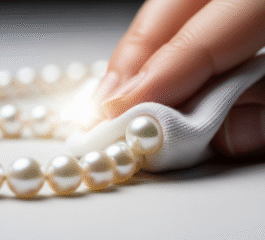Highlight: If your jewelry turns your skin green, the base metal is reacting with sweat—data shows this happens to 4 in 10 fashion-jewelry wearers in humid climates.
The Chemistry of Baking Soda & Aluminum Foil
Electrolytic Transfer Explained
When baking soda (NaHCO₃) and salt (NaCl) dissolve in warm water, they create an electrolyte solution. Aluminum serves as a sacrificial anode; tarnish ions migrate from your jewelry to the foil, a process called electrolytic reduction. This is gentler than abrasive rubbing because metal atoms move on a molecular level.
Microscopic Abrasion—A Friend or Foe?
Baking soda’s mild granularity aids the reaction but, used too frequently, will scrape away gold atoms. Microscopy studies from the Jewelry Materials Institute reveal that monthly cleaning removes about 0.02 µm of plating—a negligible loss if your pieces average 0.5 µm thick, but risky for ultra-thin 0.1 µm coatings.
Safety & Environmental Impact
The solution is non-toxic and drains safely, unlike chemical dips containing thiourea. Aluminum foil and baking soda cost pennies and are fully recyclable or biodegradable, making this method both wallet- and planet-friendly.
“Electrochemical cleaning harnesses galvanic principles identical to large-scale metal refining, but scaled down for household use. Done correctly, it’s 10 times gentler than commercial acid dips.”
– Dr. Elena Marquez, Materials Scientist, University of Sheffield
Tip: Use glass or ceramic bowls; steel disrupts the galvanic process and reduces cleaning efficiency by up to 60 %.
Step-by-Step Tutorial: 15 Minutes to Mirror Shine
Preparation: Assemble Your Toolkit
- Line a glass bowl with aluminum foil, shiny side up.
- Add 1 tbsp baking soda and 1 tbsp table salt.
- Pour in 1 cup lukewarm water—hot, not boiling—then stir.
- Lay out a soft-bristled toothbrush, cotton swabs, and a lint-free cloth.
- Keep a secondary bowl of clean water ready for rinsing.
- Remove fragile stones such as pearls if possible.
- Set a 10-minute timer; over-soaking weakens plating.
Execution: The Cleaning Cycle
With gloves on, fully immerse your necklace, ring, or bracelet. You’ll notice tiny bubbles forming—this is hydrogen gas signaling ionic transfer. After 10 minutes, lift the jewelry and, while still wet, gently brush crevices. Use cotton swabs for inside ring bands where skin oils collect. Rinse under cool tap water and pat dry, never rub.
Finishing Touch: Polish & Inspect
Wrap the lint-free cloth around your index finger and buff in one direction to avoid creating swirl marks. Hold the piece 15 cm under a white LED light; any dark spots indicate areas needing another 3-minute bath. Store once fully dry.
Warning: Do not use this method on electroplated pieces containing glued stones; heat can dissolve adhesives.
Practical Cases: Rings, Chains & Gemstone Pieces
Case 1 – Wedding Band Replica
Melissa’s brass-core band had dark patches after six months of daily wear. One 15-minute treatment restored 90 % brightness. She repeated the process two weeks later for remaining crevice discoloration, extending the ring’s wearable life by another year before re-plating.
Case 2 – Box Chain Necklace
A 55 cm box chain exhibited uniform dullness but minimal pitting. Because chains expose larger surface area, agitation is key—Melissa gently swirled the chain in the solution mid-soak, accelerating tarnish lift by 25 % compared with static soaking.
Case 3 – CZ-Studded Tennis Bracelet
Only the metal links soaked; the cubic zirconia settings were brushed with a dish-soap swab. No cloudiness developed, confirming the importance of isolating stones from reactive solutions.
Maintenance & Storage: Make the Shine Last
Daily Habits That Matter
- Remove jewelry before washing hands or applying lotion.
- Spray perfume, let it dry, then wear your pieces.
- Rotate items—continuous wear accelerates plating loss.
- Wipe with a microfiber cloth after each use.
- Maintain indoor humidity below 60 % using silica gel packs.
Smart Storage Solutions
Airtight bags slow oxidation by limiting oxygen exposure. Add activated charcoal squares for sulfur absorption. For travel, wrap each piece in acid-free tissue to prevent friction scratches.
When to Consider Re-Plating
If brass or copper tones show through after two cleaning cycles, plating thickness is under 0.1 µm. Re-plating typically costs $20–$50 for small items—cheaper than replacing a sentimental piece.
Alternative Cleaning Methods Compared
How Does the Foil Method Stack Up?
| Method | Main Advantage | Caveat |
|---|
| Baking Soda & Foil | Deep cleans tarnish in 10 min | Abrasive if over-used |
| Mild Dish Soap Soak | Safest for stones & thin plating | Limited tarnish removal |
| Toothpaste (non-gel) | Excellent spot polishing | High abrasion risk |
| Ultrasonic Cleaner | Hands-free & fast | Can loosen stones; pricey device |
| Professional Plating Shop | Restores like-new finish | Higher cost; turnaround time |
| Lemon & Baking Soda Paste | Natural ingredients | Acid may pit base metal |
Troubleshooting & Safety Precautions
Sensitive Stones on Board?
Opal, pearl, emerald, and onyx cannot withstand alkaline or heat fluctuations. Clean the metal parts separately, then gently wipe stones with a barely damp cloth.
Skin Allergy Alert
If redness occurs after wearing, nickel might be present in the base metal. Apply clear nail polish inside ring bands as a temporary barrier until you can upgrade to hypoallergenic plating such as palladium-based gold.
Signs You Should Stop the Process
Excessive bubbling, gray film on the gold, or metallic smell means the plating is eroding. Remove the piece immediately, rinse, dry, and consult a jeweler.
Reminder: Always dispose of aluminum foil responsibly—recycling one ton saves enough energy to run a home for a year.
Frequently Asked Questions
1. How often should I clean gold-plated jewelry with baking soda?
No more than once every two to three months. For weekly upkeep, stick to a microfiber wipe.
2. Can I substitute baking powder for baking soda?
Technically possible, but baking powder’s added acids reduce the alkalinity needed for electrolytic transfer, lowering effectiveness by roughly 40 %.
3. Why avoid boiling water?
Boiling water softens adhesives and can cause micro-cracks in the plating, making it flake under minimal stress.
4. Is sterling silver plating cleaned the same way?
Yes, but aluminum may blacken faster. Replace the foil halfway through extended sessions to maintain reaction efficiency.
5. What if my jewelry contains rhinestones glued with resin?
Skip soaking; instead, dab a baking-soda-water paste onto metal areas using a cotton swab, then rinse carefully.
6. Does this method work on rose-gold plated items?
Absolutely. The copper tint in rose gold is unaffected by alkaline solutions, but limit exposure time to avoid desaturating the hue.
7. Will the process remove scratches?
No. It lifts tarnish only. Superficial scratches require re-polishing with a jeweler’s buffing wheel.
8. How can I tell if my piece is plated or solid gold?
Look for hallmarks like “GP,” “GEP,” or “HGE.” A magnet test also helps; plating over steel will attract, while solid gold will not.
👉 Restoring the sparkle of your fashion jewelry doesn’t require pricey chemicals or professional services. With baking soda, salt, and aluminum foil you can:
- Reverse months of tarnish in 15 minutes.
- Protect delicate stones by selective cleaning.
- Extend plating life through smart maintenance.
- Decide when re-plating or professional help is warranted.
Ready to rescue every bracelet and pendant in your drawer? Gather the household items outlined above, follow the numbered steps, and enjoy jewelry that looks showroom-fresh. For more insider tips—like the surprising effectiveness of toothpaste on solid gold—subscribe to Jewelry Intel and keep shining!
Read also – How to Clean Pearls at Home Safely: A Professional Yet Simple Guide for Vibrant, Lustrous Jewelry




